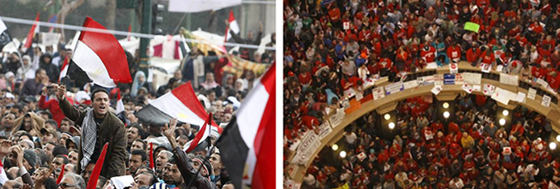Communication pundits had, until recently, been mourning the apparent demise of public assembly as a form of discourse, given the Internet’s enabling of citizens to let off steam online. With only a minimal effort, folks could speak their mind in the belief—accurate or otherwise—that they had an international audience’s attention with their Tweets, blogs and Facebook posts.
The Internet fuels an inflated sense of self-importance, creating the feeling that one is somehow making a difference in the course of events by weighing in on them online. So, why bother to get a real soapbox when a digital one means you never to have to leave the comfort of your nearest Starbucks?
Add to this the ability to provide commentary on virtually every article or news report being written today, and you have a massive public discourse, yet one that lacks the passion and vitality of, say, Martin Luther King’s 1963 March on Washington or Tiananmen Square in 1989. Something is missing here.
The Internet allows us, in the words of Sherry Turkle to be “alone together.”
Well, that all seems to be changing. Witness two new movements where the physical presence of people gathered in one place to voice an idea is taking hold: the pro-democracy protests spreading across the Middle East; and the public employee union demonstrations in the Midwestern US.

These two movements—however removed from each other in geography, culture and the stakes involved—have one thing in common: real people gathered together in large numbers to have their collective voice be heard.
So you have to ask yourself: What’s more powerful? 1,000 names on an online petition? Or 1,000 people occupying a state building? Or 100,000 people gathered on the streets of Cairo?
A crowd always draws an audience, and these Middle East and Midwest gatherings are no different. They provide the news media with impressive images, video clips and compelling sound-bytes.
What’s noteworthy to observe is how the physical gathering of people in one location inspires similar action in other places. Protests that were unimaginable just weeks ago are now metastasizing across volatile Middle Eastern borders. A similar dynamic that started in Wisconsin created a string of protests across other Midwestern states.
In this country, the Tea Party movement had already begun to point the way back to such powerful gatherings, culminating in Glenn Beck’s Restoring Honor march in Washington DC last August. The event was simultaneously cynical yet oddly reverent toward its predecessor, the MLK march on Washington on the same date and place 47 years earlier. The sheer mass of attendees at Beck’s event surprised the mainstream media and grabbed the attention of millions of Americans in the process. The Tea Party will likely provide the media with many more such gatherings to leverage a voracious appetite for attention-grabbing video. With the 2012 national elections already looming, the Tea Party could have an even bigger impact than ever, with more and larger gatherings. (Now if only they could start running spell-check on their protest signs before the cameras roll…)
So whether it’s the protests in the Wisconsin state capitol, or in the cities and towns of Libya, it’s clear that feet-on-the-street is back. It will likely become part of the new normal. “Policy only responds to pressure” as they say, and the pressure of thousands of people gathered together possesses far greater impact than a million Facebook “LIKE” buttons being clicked.
That’s not to say digital media plays no role. It is worth noting that these people-in-the-street movements actually owe quite a lot to the technology of social media, especially it its mobile form via smartphones that rally people to the right place for protest, and then become broadcast platforms through Twitter, Flickr, Facebook and YouTube. This feedback loop of physical gatherings and digital dissemination ends up giving both modes of communication more power.
Nevertheless, digital can only take us so far. Humanity—flesh and blood humanity—remains the most powerful force for moving ideas forward.